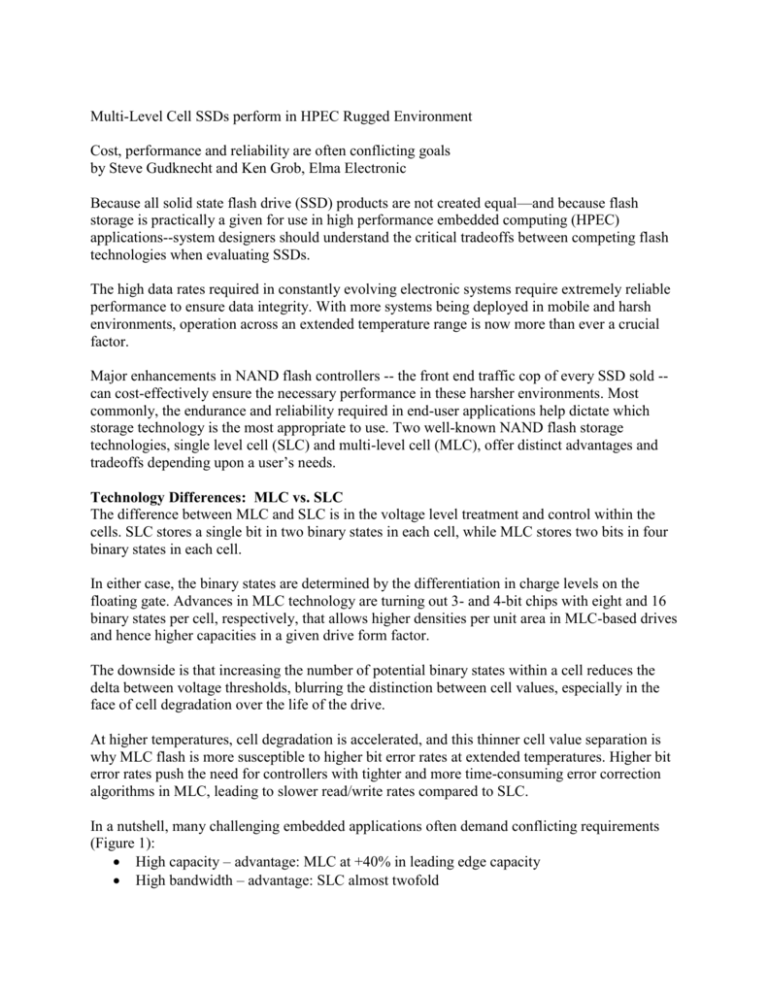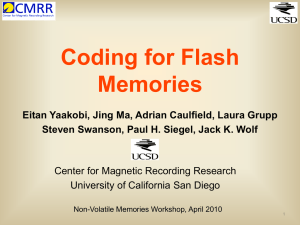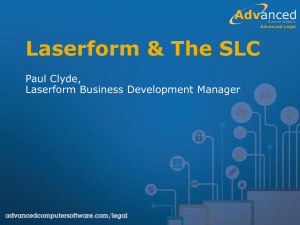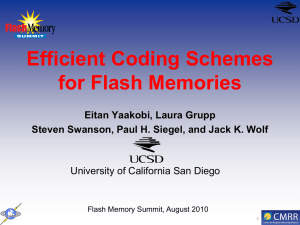RTC10 IWTW Elma_original
advertisement

Multi-Level Cell SSDs perform in HPEC Rugged Environment Cost, performance and reliability are often conflicting goals by Steve Gudknecht and Ken Grob, Elma Electronic Because all solid state flash drive (SSD) products are not created equal—and because flash storage is practically a given for use in high performance embedded computing (HPEC) applications--system designers should understand the critical tradeoffs between competing flash technologies when evaluating SSDs. The high data rates required in constantly evolving electronic systems require extremely reliable performance to ensure data integrity. With more systems being deployed in mobile and harsh environments, operation across an extended temperature range is now more than ever a crucial factor. Major enhancements in NAND flash controllers -- the front end traffic cop of every SSD sold -can cost-effectively ensure the necessary performance in these harsher environments. Most commonly, the endurance and reliability required in end-user applications help dictate which storage technology is the most appropriate to use. Two well-known NAND flash storage technologies, single level cell (SLC) and multi-level cell (MLC), offer distinct advantages and tradeoffs depending upon a user’s needs. Technology Differences: MLC vs. SLC The difference between MLC and SLC is in the voltage level treatment and control within the cells. SLC stores a single bit in two binary states in each cell, while MLC stores two bits in four binary states in each cell. In either case, the binary states are determined by the differentiation in charge levels on the floating gate. Advances in MLC technology are turning out 3- and 4-bit chips with eight and 16 binary states per cell, respectively, that allows higher densities per unit area in MLC-based drives and hence higher capacities in a given drive form factor. The downside is that increasing the number of potential binary states within a cell reduces the delta between voltage thresholds, blurring the distinction between cell values, especially in the face of cell degradation over the life of the drive. At higher temperatures, cell degradation is accelerated, and this thinner cell value separation is why MLC flash is more susceptible to higher bit error rates at extended temperatures. Higher bit error rates push the need for controllers with tighter and more time-consuming error correction algorithms in MLC, leading to slower read/write rates compared to SLC. In a nutshell, many challenging embedded applications often demand conflicting requirements (Figure 1): High capacity – advantage: MLC at +40% in leading edge capacity High bandwidth – advantage: SLC almost twofold High endurance – advantage: SLC by a factor of 20 Low cost – advantage: MLC at 70% below SLC Extended temperature operation – advantage: SLC at equal bandwidth Market Need Low price and higher drive capacities in MLC are attractive to cost-sensitive industrial and mil program designers who consider deploying them in harsh environments, where hot and cold extremes are common and endurance is paramount. In an age of ever-tightening budgets, economic viability must be achievable across platform designs and cannot be a barrier to implementation, but when SLC drives cost on the order of 2 to 4 times that of equivalent capacity MLC drives, you can guess where the money wants to go. Lower MLC bandwidth issues can be addressed via improved flash controllers inside the drives, however it would seem that trouble will arise when low cost/high capacity requirements clash with high endurance/high temperature requirements. Looks can be deceiving and unlike the saying, “Get it good, fast and cheap…pick any two,” the need to compromise is fast diminishing as advanced SSD controller technology helps boost MLC performance. Extending MLC into the SLC Space Until recently, MLC flash was only recommended for use in commercial temperature environments where the top end approached only 70°C. Many military applications, as well as some industrial applications, call for rugged equipment to operate at temperatures up to 85°C. While SLC solutions are certainly able to address those applications from an environmental and operational standpoint, the sticking point has always been the entry price. Increased operational temperatures have the nasty habit of causing higher bit error rates and so SSD suppliers enlist a barrage of controller-based management features designed to mitigate if not eliminate the effects of bit errors. Major SSD manufacturers like Soligen, Memkor and others provide industrial temperature validated MLC drives. So advancements in NAND flash controllers have begun to close the MLC/SLC gap and SSD manufacturers, according to Mark Ayers of Soligen, are taking full advantage of that fact. Ayers notes that modern NAND controllers offer features such as (Figure 2): Error correction code (ECC) recovery of up to 55 bits correctable per 512-byte sector Unrecoverable read errors of less than 1 sector per 1017 bits read ECC on all internal memory and end-to-end cyclic redundancy check (CRC) protection Redundant NAND cell technology providing additional levels of data protection Over-provisioning for enhanced drive life span Wear leveling for enhanced drive endurance and life span As you can imagine, all of that ECC overhead takes its toll on bandwidth and is the reason why inherent MLC bandwidth at the chip level is about 30% lower compared to SLC. Help has arrived, however, in the form of more effective internal flash organization, including I/O lane multiplication and improved management processes resident in the controller firmware. These internal enhancements increase the number of read/write operations per second and reduce the lower bandwidth issue for MLC. In real terms this simply means that, thanks to flash controller technology and internal architecture, a 2.5" SATA 3 drive will operate at the specified theoretical maximum bandwidth of 6 Gbit/s, regardless of whether it’s MLC or SLC. The same goes for all form factor drives. Taken in that absolute sense, MLC and SLC drives of identical form factor can be equal in bandwidth capability, even though their underlying cell technology is not the same. Many applications are well suited for MLC drive technology since the write/erase rate is inherently low. As the aggregate ingest bandwidth increases in today’s data gathering applications, the system back-end must respond. In platforms that must buffer, store or perform a combination of pre-processing and buffering, the system record rate is driven to increase and capacities must rise. According to Ayers, single mission data collection applications—where large blocks of sequential data are recorded at a single pass—are perfect environments for MLC drives. In many recording applications for video data, radar data and flight data logging, the data recording capacity exceeds the maximum single mission flight time. In these cases, the recorded data is erased after each mission download. MLC can safely provide many years of service in military and industrial environments depending on the traffic usage case. Modern MLC or SLC NAND-based SSDs have already achieved very good read and large block sequential write performance in these types of applications, according to Wieslaw Wojtczak, CTO of Memkor. The key focus for SSD manufacturers, comments Wojtczak, is to enhance small block random write performance by minimizing various latencies and in high speed multiSSD RAID applications—by minimizing RAID response delays. According to Wojtczak, in addition to long used DRAM caching, the most efficient approach so far in enhancing SSD bandwidth (MLC or SLC) is the use of overprovisioning. Overprovisioning, in this case, sets aside as much as 20-30% of the drive capacity as a work space for smart data processing and allows flash management background processes, like garbage collection, to run more effectively. Flash storage uniquely mandates that all old data must be erased before new data can be written. Since the entire flash block is erased at one time, valid data must be separated from invalid and moved to another location, so the block with only invalid data can be erased. This is known as garbage collection. This overhead write penalty is a key factor in “write amplification” as it slows down write speeds and increases cell degradation. Smart data processing and optimized garbage collection routines allow increased performance, ensure performance stability over the usage of the SSD and decrease the write amplification factor. Overprovisioning is most important for enterprise class applications, where users access data at an extremely high rate with a high constant rate of random writes. Endurance and drive life Wider design and operating margins in SLC flash lead to higher reliability, better endurance and longer life when compared to MLC flash. Drive manufacturers specify endurance as the number of block level write/erase cycles allowed before errors rise to unacceptable levels causing drive failures. SLC flash endurance stands at 10 to 20 times that of MLC. To address whether to use SLC or MLC, systems that rely on SSDs need a reliable method to alert users of the useful remaining drive life and then generate warning messages intended to trigger preventative maintenance. This process, known as self-monitoring, analysis and reporting technology—or SMART—is an open standard algorithm that enables SSDs to continuously monitor cell wear and send an alert to the user of impending cell failures. To maximize drive life, wear leveling is employed. Wear leveling uniformly spreads writes over the entire physical array rather than continuously writing information to the same blocks. The controller manages this by maintaining a virtual map of the flash surface that points to the ever changing physical locations. As blocks reach their endurance maximum, they are relegated to bad block status and no longer accessed. Wear leveling and SMART are key features when considering any type of flash, but are particularly important where MLC flash is concerned. Conclusion Widespread adoption of MLC flash-based SSDs in military and industrial applications is being enabled by advancements in flash controller technology. Operation in extreme temperatures imposes performance demands that test the inherent limitations of MLC flash, as designers seek to take advantage of its low cost in these applications. Controller-based flash management technologies, like wear leveling, error correction, garbage collection, overprovisioning and SMART, combine to make MLC flash a worthy contender for usage in appropriate harsh environment applications. SIDEBAR: Example Storage Recorder Topology OpenVPX, or VITA 65, supports HPEC recording and is built on VITA 46 using the multi-gig connector that supports differential signals such as SATA or SAS used in building storage arrays. An 8-channel OpenVPX RAID Controller packages two 2 1/2" SSDs per 3U VPX card. Up to eight drives can be mounted across four slots. This array uses one drive controller/dual drive carrier card and three OpenVPX dual drive carrier cards. The current capacity is 8 TB, and will soon be extended to 16 TB as drive capacities increase. Typical data rates can reach as high as 380 Gbit/s, depending on other variables such as operating system and driver optimization, and the controller can operate successfully in -40°C to +85°C environments. Elma Electronic, Fremont, CA. Figure Captions: Figure 1: Both MLC & SLC have distinct advantages, depending on the application needs. Figure 2: Advancements in NAND flash controllers have lessened the performance gap between MLC & SLC.








